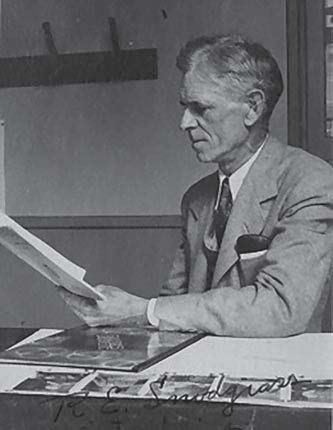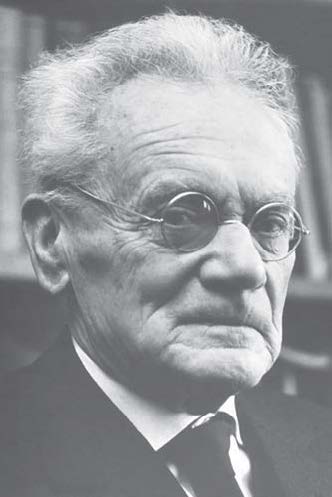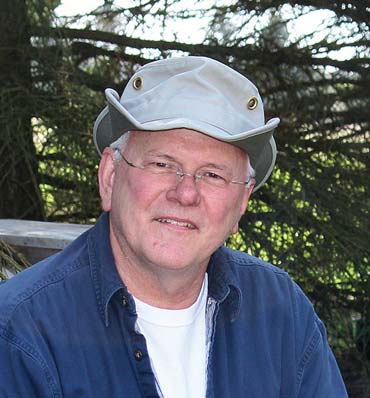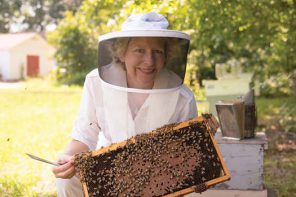By: James Tew
Yes, we had cars when I was a kid
In my life’s experiences, I have found that very old people and very young people speak their minds. Upon a visit to my ninety-five-year-old grandmother, she giggled an old lady chuckle, and bluntly said, “Jimmy, you are fat!”
From the clear blue sky, my youngest grandson recently asked, “Grandpa, when you were a kid, did they have cars?” Yes, they had cars when I was a kid, but no, we did not have the hugely powerful internet nor camera phones. Just a few decades ago, I would not have been able to conceive of streaming video. Feeling much like a beekeeping fossil, I learned beekeeping by talking (and listening) to others, reading, looking at bad 35mm photographic slides, and very rarely watching a 16mm movie that had been produced by professionals. Armed with my newly acquired expertise, I would jump in the deep end of the beekeeping pool, and frequently flounder. Over time, using these archaic methods, I learned a bit about beekeeping.
Beginning beekeeping is a world unto itself. In our early beekeeping years, finding the queen all by yourself or watching a worker bee “be born” were exciting events. Ironically, decades later, these small beekeeping occurrences are still entertaining, but a bit old hat. As is required of all beekeepers, that was my early beekeeping world – making mistakes, reading introductory publications, listening, and asking questions.
After being discharged from the U.S. military, I wasn’t sure what to do with my life. I decided to go to graduate school and specialize in entomology. All those years ago, entomology was primarily pesticide driven, so I planned to become a pesticide specialist. While on that path, I literally stumbled into beekeeping, a specialized aspect of entomology. At Auburn University, Dr. Paul Estes, my advisor for my master’s degree, perceived my bee interest and encouraged me to pursue that avenue. Earlier in his life, he himself, had taken a basic bee class, but unlike me, he never lost his mind over beekeeping.
Ronald Ribbands

Ronald Ribbands. (IBRA photo)
On his entomology book shelf, Dr. Estes had copies of only two bee books: The Hive and the Honey Bee and The Behavior and Social Life of Honey Bees by Ronald Ribbands. One day, after glossing eloquently about beekeeping to Dr. Estes, he took Ribbands’ book from the shelf above his desk and told me to read it and keep it. He felt that I needed it more than he did.
Indeed, I did read it and it unexpectedly opened the portal to the next level of beekeeping for me. This was not a book about installing eyelets or making sure that hive body handholds faced outwardly. This was my first true exposure to scientific bee behavior and bee biology. It literally helped me leave the beekeeping kiddie pool and move to the large, deep, beekeeping pool. My Dad had already admonished me saying, “Jimmy, you cannot make a living with your hobby.” Not wanting to become too sentimental here, but Ribbands’ information was not hobby information. It was a compendium of the best honey bee science of the day produced by beekeeping scientists and professionals of that time (1953). No, this was not a hobby. Due in part to this book, with Dr. Estes’s support, I gave up on the pesticide circuit and moved into the academic beekeeping world. I never met Professor Ribbands or heard him speak, but his book had a definite influence on my bee life.
A confession
Dear reader, I feel a need to offer a written confession. My concept for this article was to present two to three beekeeping authorities, now passed and who I never met, but who had a contributory effect on my budding honey bee interest.
It was a component of my destiny that Dr. Estes pulled Professor Ribbands’ book from his bookshelf. Not intending to diss the good professor, but it could have been any number of other established scientists who had published results of their work. I had no hand in the selection. My confession is that while it was easy for me to select my #1 unmet authority, I must have about eight meaningful contributors in my #2 slot. I have unintentionally begun a ranking that I did not intend. Yet, Editor Jerry limits my written space, so I must comply.
S.E. Snodgrass

R.E. Snodgrass. (ARS photo)
I am surprised that I selected Dr. Snodgrass’s book, Anatomy of the Honey Bee, as one of my #2 spots. My interest and appreciation for this anatomy text was actually preceded by the text used in an insect morphology class that I successfully endured earlier. The text for the class was the archetypal, Principles of Insect Morphology, also by Snodgrass. This may have been the most educational, but yet most tedious entomology read, that I have ever undertaken. While slogging through the names of innumerable insect parts and pieces, I discovered that Dr. Snodgrass had published a specific honey bee anatomy text. Since my interest in all things bees was unbounded, I was able to make the transition from general insect morphology to more specific honey bee structures and parts. I found that change to be much more palatable.
If you decide to digest the material in this book, I need to prepare you for a serious undertaking. The information contained in this text is not casual reading, but when you get through the book, you will be an accomplished honey bee anatomist. Occasional refreshers will be required. I never met Dr. Snodgrass or heard him speak, but his books had a definite influence on my bee life.
Karl von Frisch

Karl von Frisch (Nobel Archives)
Time and again, in my early bee life, it was noted that von Frisch had been awarded the Nobel prize for his work on honey bee dance language communication. The 1973 award came in the category of Physiology or Medicine and was shared with Nikolaas Tinbergen and Konrad Lorenz. To date, this is the only Nobel award made for researchers who study insects.
Another confession that I should make is that, initially, I simply could not understand the dance diagrams presented in Professor von Frisch’s work. Figure eight layouts and sun orientation in two dimensions on the written page did not compute for me. Yet, I had to keep at it. This was a huge event in the academic bee world, and everyone else seemed to understand the material.
I don’t remember when or where, but at some point, I was able to translate the 2D diagrams into the 3D world in which I live and keep bees. Once you see it, you see it. I have several of the Professor’s books and have grown in my appreciation for the complexity that the bees exhibit in their personal lives. Though I remember his death event, I never met Professor von Frisch or heard him speak. His books, however, had a definite influence on my bee life.
Enough…
I can sense that this avenue of thought is wearing thin. I will not be able to review all my other “#2s” without bringing you to tears. Authorities like C.C. Miller, John Free, L.E. Snelgrove, Charles D. Michener, and E.O. Wilson will have to go unmentioned. But before I leave this, just one last review of a general bee book by Eckert and Shaw.
John E. Eckert and Frank R. Shaw
Of course, ABC and XYZ of Bee Culture and The Hive and the Honey Bee were staples in my early bee life, but for me at that time, there was a third book, simply titled Beekeeping by Eckert and Shaw. I read and appreciated this text and found it to be a source of alternative information to the two most famous texts of that time. It is a friendly, readable text. As both ABC and The Hive and the Honey Bee were regularly updated and republished, Beekeeping became more and more dated.
After a couple of decades passed, and since email did not exist at the time, I wrote letters to MacMillan Publishing Company in New York to ask their plans for updating and rewriting this text. It took a while, but I finally got a response telling me that the heirs to the authors still held the publications rights. I tried to write to them, but no response. I moved on. All these years later, I still find this a meaningful book, but it has become a dated text. In my earliest years, this book was one of my big three. I never met either Eckert or Shaw, or heard them speak, but their book, Beekeeping, is one of my foundational bee texts.
I am an amalgamation
Writing this piece for you has made me realize that I am a mix of all the bee authors whose work I have read, all the talks I have sat through, all the beekeepers to whom I have spoken, and my bee life’s personal experiences. I have left out, by necessity, a ridiculous number of contributors, and I have no idea where you, the reader, could find copies of the texts to which I have referred. No doubt, you have your own special sources. As you grow in beekeeping, these early aids will be meaningful to you.
A subject change – in a way

Some of the authors whose books affected my bee endeavor.
Last month, I became embroiled in my annual washboard behavior interest. Though I am afraid that you might, I never tire of speculating about this behavior. I gave the subject my best shot last month, but I went on too long and squeezed out space for one of my points of observational hive interest – gallarasis. Due to hazy contaminants on the inside of the observation hive glass, I struggled with poor quality photos that pictured this common wax moth condition.
In fact, the haze on the glass negatively affected all my observation hive pictures. In unenlightened exasperation, I suddenly asked myself, “What is this hazy material that is so pervasive on the inside surfaces of the glass walls?”
It would appear to be time for my monthly admission that my comments here are not science, but simple conjecture. I’m guessing the haze is caused by innumerable bees walking on propolis/wax comb surfaces, and then – over time – transferring that mixture (propolis) to the glass surface.
Since I have admitted that I talk to myself, I then asked myself if this thin-film mixture offered bactericidal protection to the hive occupants? Then I surmised – ergo, no science – that if this propolis haze is on the glass, it must also cover all the inside surfaces of the observation hive, and most likely, even coat the bees. Therefore, if I am seeing this film in my observation hive, it would logically follow that it would be found coating the insides of any honey bee nest cavity.
My partial thoughts then culminated in the broad question, “Does this thin film offer antimicrobial protection to colony members?” That followed with my wildly speculative supposition, “Are the wash boarding bees that I (apparently) see throughout the hive laying down this thin film, or is it simply a biproduct of thousands of dirty bee feet?” Both? I don’t know.
My monthly best guess is that this film doesn’t hurt the colony and is most likely beneficial to the colony inhabitants. You and I know, from the beekeeping literature, that propolis is a major colony product and that it is biologically active. While we as beekeepers bemoan the ever present propolis mess on our hands and the increased difficulty in removing soundly stuck frames, I suspect that propolis is vital to a healthy, productive colony. (So, what would this mean for a 3-pound package installed on new equipment? Is that new colony more biologically vulnerable? Get ready – I don’t know.)
Once again, any comments I had planned to make on gallarasis have been squeezed out. Spoiler alert – I am guessing that this wax moth condition is more prevalent than we know, but I will again try to review this condition next month.
Final word about this film business
Propolis is obviously an important component of honey bee nest ecology. I wish we knew more about it. Any of you feed propolis? Any of you offer gum supplements to your colonies? Any of you cultivate plants specifically for gum sources for bees. Nope. In every other way, we provide for our bee colonies, but when it comes to propolis (gum), the bees are strictly on their own. They clearly want this stuff.
Thank you
I always appreciate you reading my ramblings. Clearly, without readers, a writer serves no purpose. Thank you.
Dr. James E. Tew, Emeritus Faculty, Entomology, The Ohio State University and One Tew Bee, LLC; tewbee2@gmail.com; http://www.onetew.com









